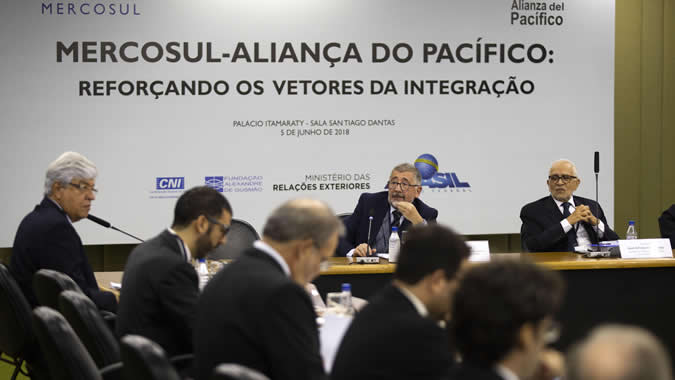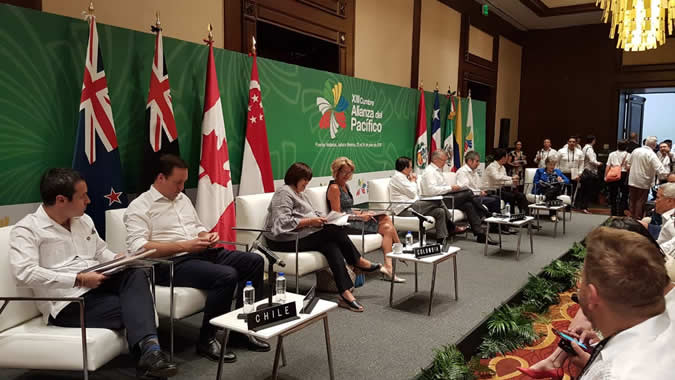Deepening Regional Integration is an Imperative for Facing International Turbulence
Work area(s)
A new publication by ECLAC indicates that convergence between the Pacific Alliance and MERCOSUR is “necessary and urgent.”

In a context as turbulent as the current one, where there is increased questioning of globalization and heightened migratory and trade tensions, deepening regional integration is not an option but rather an imperative. Thus, the convergence between the Pacific Alliance and the Southern Common Market (MERCOSUR) is both necessary and urgent, the Economic Commission for Latin America and the Caribbean (ECLAC) emphasizes in the document The Convergence between the Pacific Alliance and MERCOSUR: Facing Together a Challenging Global Scenario (available only in Spanish and Portuguese).
According to the report, which was presented on Tuesday, June 5, 2018 in Brasilia during the seminar “MERCOSUL-Aliança do Pacífico: Reforçando os Vetores da Integração”, it is crucial to bridge the gaps between the region’s main economic integration mechanisms. For example, the Pacific Alliance and MERCOSUR together account for around 80% of the region’s population and of its GDP, around 85% of its trade, and nearly 90% of its Foreign Direct Investment (FDI) flows.
In the publication’s foreword, ECLAC’s Executive Secretary, Alicia Bárcena, indicates that “ECLAC has supported the process of ‘convergence in diversity’ between the Pacific Alliance and MERCOSUR since it was initially proposed by the government of Chile in 2014. In effect, given the strong economic and demographic weight of both groups, their convergence would become a powerful catalyst for integration of the region as a whole. This is an innovative proposal, based on an approach of gradual progress that enables the conditions for considering more ambitious goals.”
Latin America and the Caribbean, along with Africa, presents the lowest rates of intraregional trade in the world: just 16% of the value of its exports is aimed at the region itself, far below the 50% seen in East Asia and North America and the European Union’s 64%. In addition, productive chains between countries of the region are generally scarce and weak.
The study indicates that the great potential offered by the market of Latin America and the Caribbean, with its more than 640 million inhabitants, is still not being taken advantage of fully. This is due in part to the fragmentation of the regional economic space, which manifests itself in the coexistence of various economic integration mechanisms, each one of which has created its own rules on issues ranging from sanitary and consumer-protection regulations to public purchasing and the handling of foreign investment.
These regulatory discrepancies impose high costs on companies (especially small and medium-sized enterprises, or SMEs) that want to export to the regional market or invest in it, and they hinder the development of regional value chains, the report adds.
In 2017, the value of trade between the Pacific Alliance and MERCOSUR experienced a significant recovery (17%) and totaled $36.5 billion dollars, after having suffered four straight years of declines, with a cumulative contraction of 38% versus its value in 2012 (when it reached a peak of nearly $51 billion dollars).
In the report, ECLAC proposes five areas of joint work between both blocs, in the context of a new phase of the convergence process. These are: greater regulatory cooperation and reduction of technical obstacles to trade; investment facilitation; mutual recognition of the national Authorized Economic Operator programs; advancing toward a regional digital market; and cooperation in the development of statistics on trade in services.
Related content

Convergencia entre la Alianza del Pacífico y el MERCOSUR es necesaria y urgente: CEPAL
Secretario Ejecutivo Adjunto a.i. del organismo, Mario Cimoli, participó en Brasilia en un seminario que analizó la importancia de profundizar los vínculos entre ambos bloques.

ECLAC Reiterates Commitment to Supporting the Pacific Alliance and Praises Efforts Aimed at Convergence with MERCOSUR
During the 13th ministerial summit being held in Puerto Vallarta, the organization’s Executive Secretary, Alicia Bárcena, also called for deepening the bloc’s relationship with Australia, Canada, New…
Contact
Public Information Unit
- prensa@cepal.org
- (56 2) 2210 2040